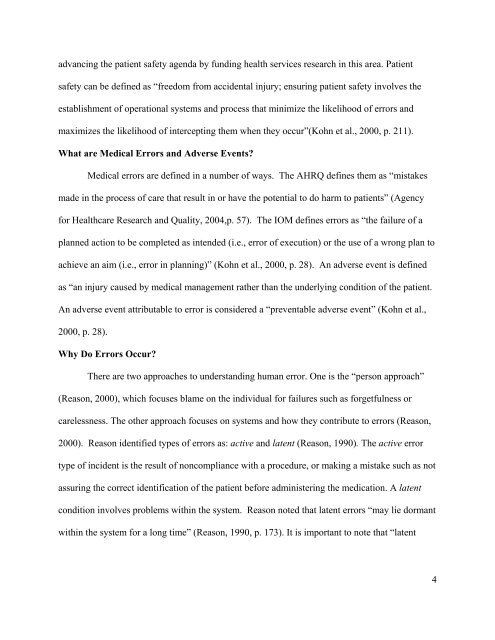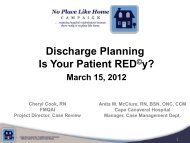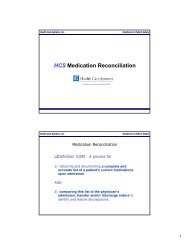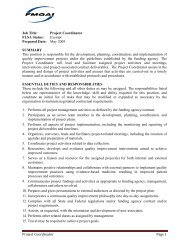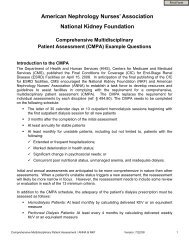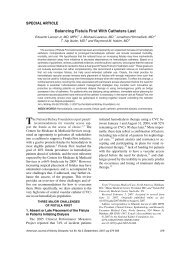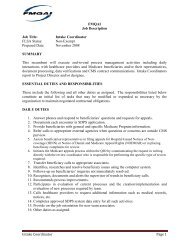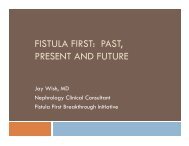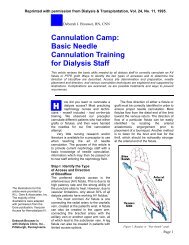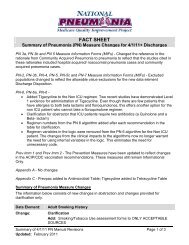The Nurse's Role in Promoting a Culture of Patient Safety - FMQAI
The Nurse's Role in Promoting a Culture of Patient Safety - FMQAI
The Nurse's Role in Promoting a Culture of Patient Safety - FMQAI
You also want an ePaper? Increase the reach of your titles
YUMPU automatically turns print PDFs into web optimized ePapers that Google loves.
advanc<strong>in</strong>g the patient safety agenda by fund<strong>in</strong>g health services research <strong>in</strong> this area. <strong>Patient</strong><br />
safety can be def<strong>in</strong>ed as “freedom from accidental <strong>in</strong>jury; ensur<strong>in</strong>g patient safety <strong>in</strong>volves the<br />
establishment <strong>of</strong> operational systems and process that m<strong>in</strong>imize the likelihood <strong>of</strong> errors and<br />
maximizes the likelihood <strong>of</strong> <strong>in</strong>tercept<strong>in</strong>g them when they occur”(Kohn et al., 2000, p. 211).<br />
What are Medical Errors and Adverse Events?<br />
Medical errors are def<strong>in</strong>ed <strong>in</strong> a number <strong>of</strong> ways. <strong>The</strong> AHRQ def<strong>in</strong>es them as “mistakes<br />
made <strong>in</strong> the process <strong>of</strong> care that result <strong>in</strong> or have the potential to do harm to patients” (Agency<br />
for Healthcare Research and Quality, 2004,p. 57). <strong>The</strong> IOM def<strong>in</strong>es errors as “the failure <strong>of</strong> a<br />
planned action to be completed as <strong>in</strong>tended (i.e., error <strong>of</strong> execution) or the use <strong>of</strong> a wrong plan to<br />
achieve an aim (i.e., error <strong>in</strong> plann<strong>in</strong>g)” (Kohn et al., 2000, p. 28). An adverse event is def<strong>in</strong>ed<br />
as “an <strong>in</strong>jury caused by medical management rather than the underly<strong>in</strong>g condition <strong>of</strong> the patient.<br />
An adverse event attributable to error is considered a “preventable adverse event” (Kohn et al.,<br />
2000, p. 28).<br />
Why Do Errors Occur?<br />
<strong>The</strong>re are two approaches to understand<strong>in</strong>g human error. One is the “person approach”<br />
(Reason, 2000), which focuses blame on the <strong>in</strong>dividual for failures such as forgetfulness or<br />
carelessness. <strong>The</strong> other approach focuses on systems and how they contribute to errors (Reason,<br />
2000). Reason identified types <strong>of</strong> errors as: active and latent (Reason, 1990). <strong>The</strong> active error<br />
type <strong>of</strong> <strong>in</strong>cident is the result <strong>of</strong> noncompliance with a procedure, or mak<strong>in</strong>g a mistake such as not<br />
assur<strong>in</strong>g the correct identification <strong>of</strong> the patient before adm<strong>in</strong>ister<strong>in</strong>g the medication. A latent<br />
condition <strong>in</strong>volves problems with<strong>in</strong> the system. Reason noted that latent errors “may lie dormant<br />
with<strong>in</strong> the system for a long time” (Reason, 1990, p. 173). It is important to note that “latent<br />
4


